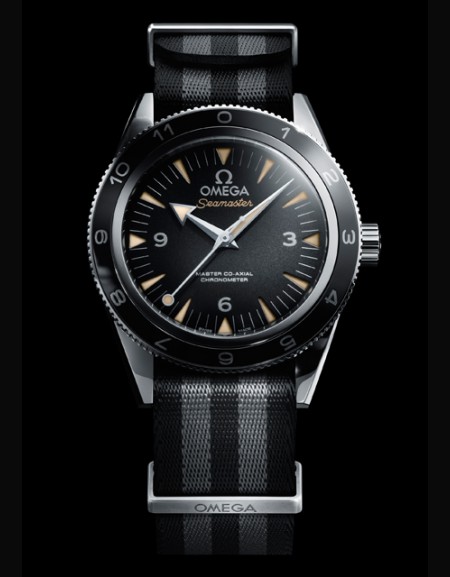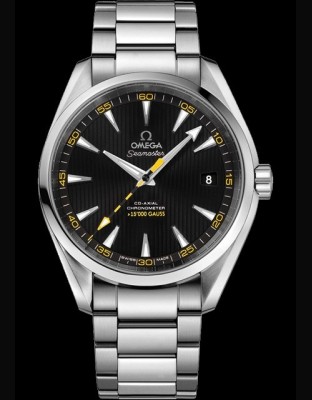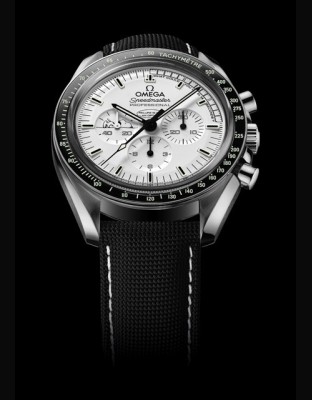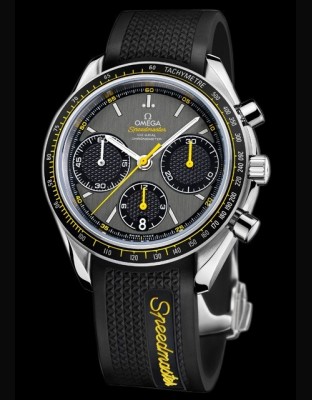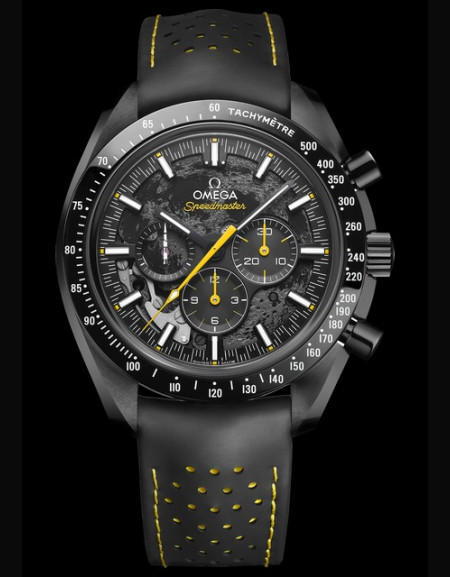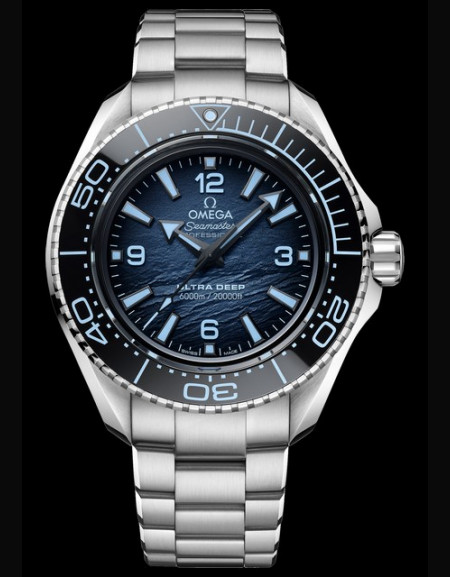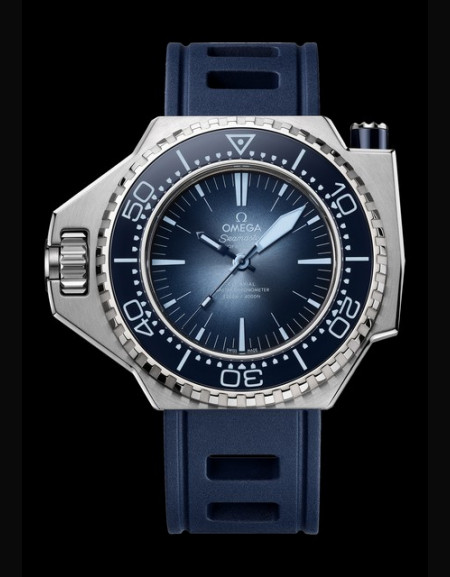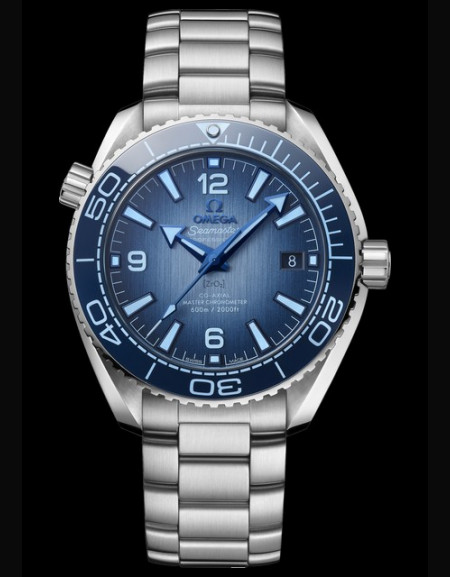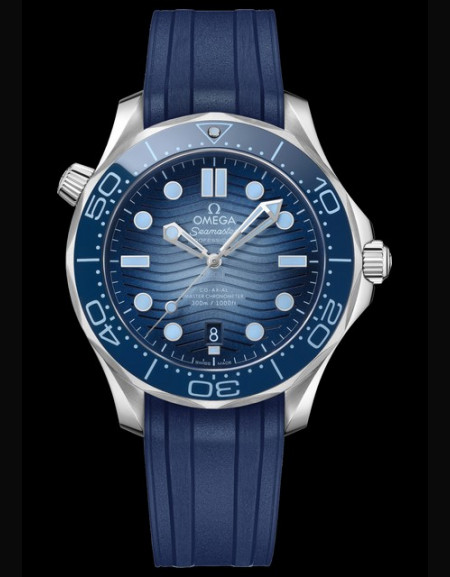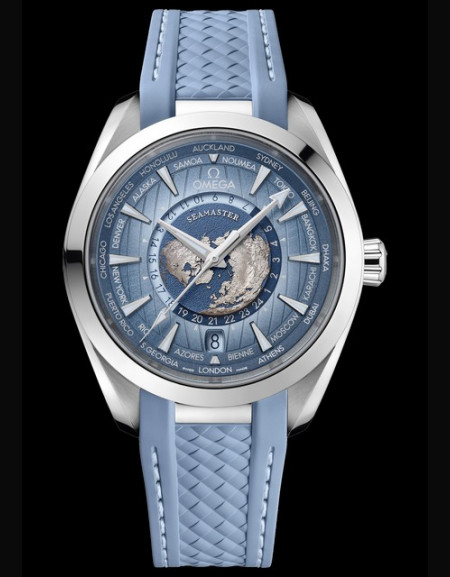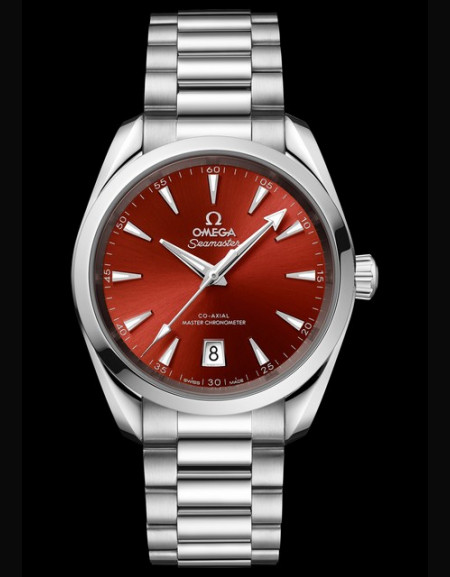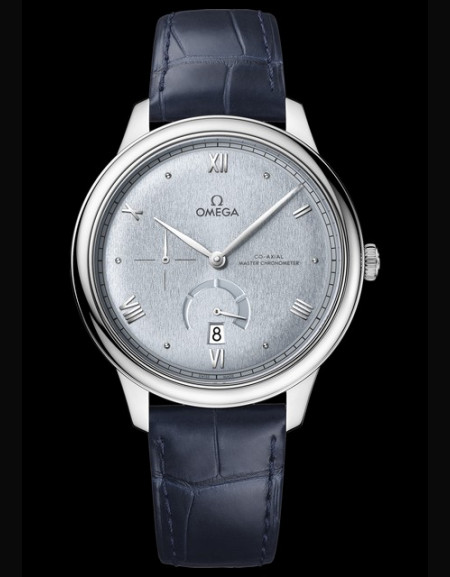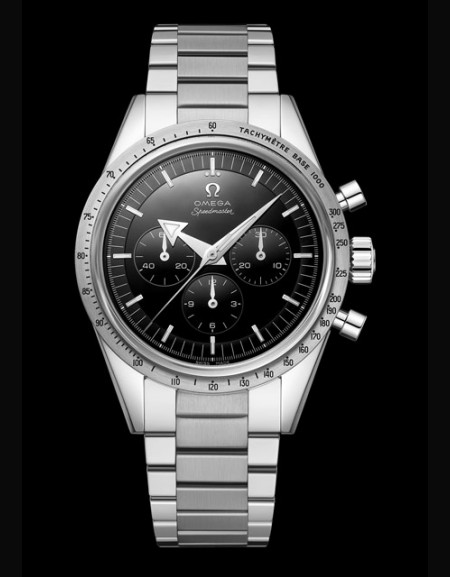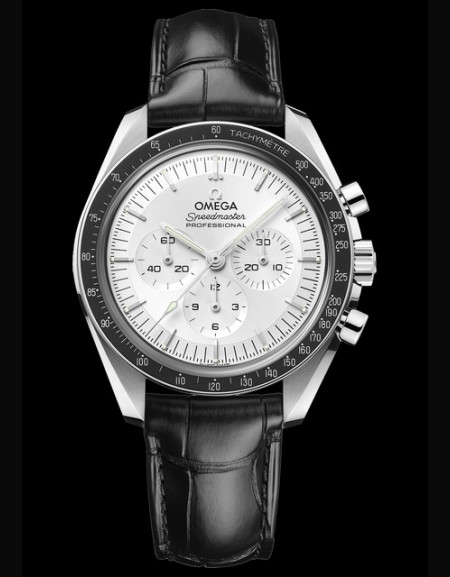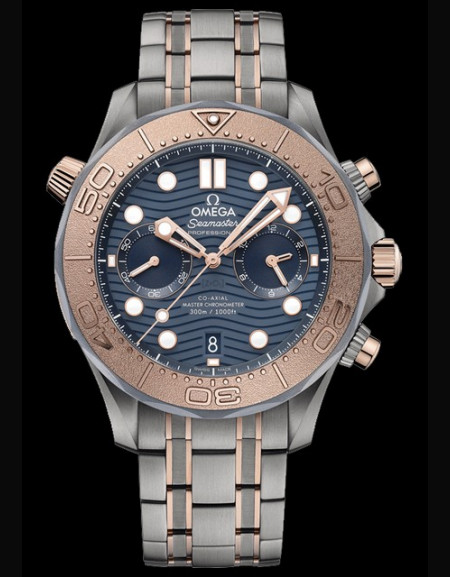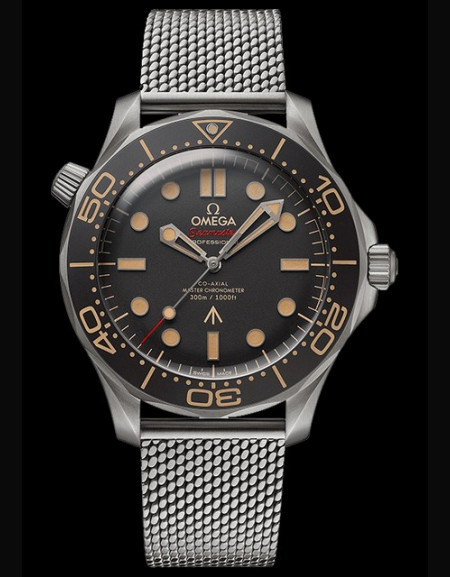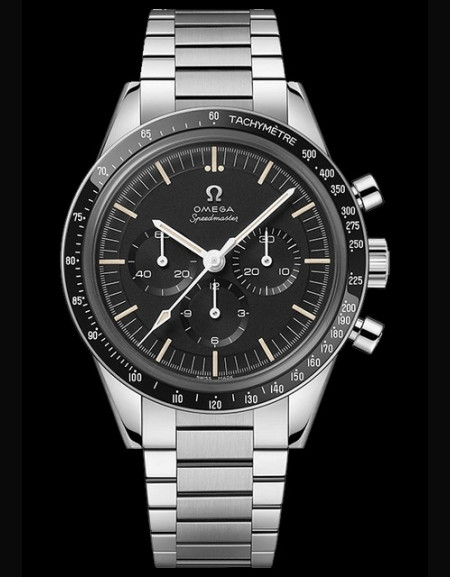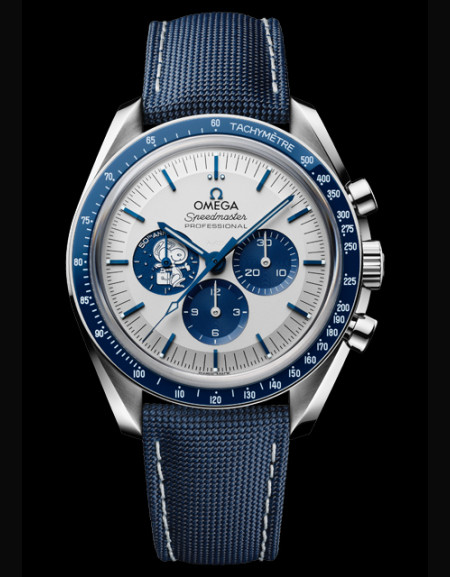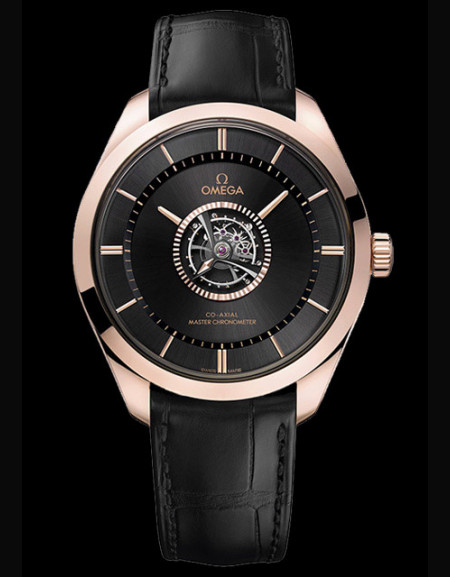
|
||
Omega Saga
Omega : 24th and last letter of the Greek alphabet. The alpha and the omega : the beginning and the end. Omega is therefore synonymous with accomplishment, finishing, perfection, summum, maximum, crowning achievement and excellence.
FROM LOUIS BRANDT TO NICOLAS HAYEK
1848 : In La Chaux-de-Fonds, Louis Brandt establishes a 'comptoir d'établissage' [assembly workshop] at the age of 23.
1880 : One year after the death of their father, Louis-Paul and his brother César Brandt establish the company in Bienne, where they transform it into a...

MY WATCHSITE CHOICE

-
Seamaster 300 Spectre...
SEE THE DATA SHEETBrand: Omega
Collection: Seamaster
Ref: 233.32.41.21.01.001
Price: 6 300 € -
Aqua Terra 15,000
SEE THE DATA SHEETBrand: Omega
Collection: Seamaster
Ref: 231.10.42.21.01.002
Price: 5 500 € -
Speedmaster Apollo 13...
SEE THE DATA SHEETBrand: Omega
Collection: Speedmaster
Ref: 311.32.42.30.04.003
Price: 6 000 € -
Speedmaster Racing
SEE THE DATA SHEETBrand: Omega
Collection: Speedmaster
Ref: 326.32.40.50.06.001
Price: 3 900 €

THE COLLECTIONS

-
Speedmaster Dark Side of...
SEE THE DATA SHEETBrand: Omega
Collection: Speedmaster
Ref: 310.92.44.50.01.001
Price: 15 700 € -
Seamaster Planet Ocean 6000M
SEE THE DATA SHEETBrand: Omega
Collection: Seamaster
Ref: 215.30.46.21.03.002
Price: 14 300 € -
Seamaster Ploprof 1200M
SEE THE DATA SHEETBrand: Omega
Collection: Seamaster
Ref: 227.32.55.21.03.001
Price: 15 700 € -
Seamaster Planet Ocean 600M
SEE THE DATA SHEETBrand: Omega
Collection: Seamaster
Ref: 215.30.40.20.03.002
Price: 8 200 € -
Seamaster Diver 300M
SEE THE DATA SHEETBrand: Omega
Collection: Seamaster
Ref: 210.32.42.20.03.002
Price: 6 500 € -
Seamaster Diver 300M
SEE THE DATA SHEETBrand: Omega
Collection: Seamaster
Ref: 210.30.42.20.03.003
Price: 6 900 € -
Seamaster 300
SEE THE DATA SHEETBrand: Omega
Collection: Seamaster
Ref: 234.30.41.21.03.002
Price: 8 200 € -
Seamaster Aqua Terra 150M
SEE THE DATA SHEETBrand: Omega
Collection: Seamaster
Ref: 220.12.43.22.03.002
Price: 10 900 € -
Seamaster Aqua Terra 150M
SEE THE DATA SHEETBrand: Omega
Collection: Seamaster
Ref: 220.10.43.22.03.002
Price: 11 200 € -
Seamaster Aqua Terra 150M
SEE THE DATA SHEETBrand: Omega
Collection: Seamaster
Ref: 220.12.41.21.03.008
Price: 7 000 € -
Seamaster Aqua Terra 150M
SEE THE DATA SHEETBrand: Omega
Collection: Seamaster
Ref: 220.10.41.21.03.005
Price: 7 300 € -
Seamaster Aqua Terra 150M
SEE THE DATA SHEETBrand: Omega
Collection: Seamaster
Ref: 220.10.38.20.03.004
Price: 7 600 € -
Aqua Terra 150M
SEE THE DATA SHEETBrand: Omega
Collection: Seamaster
Ref: 220.10.38.20.13.003
Price: 7 100 € -
Aqua Terra 150M
SEE THE DATA SHEETBrand: Omega
Collection: Seamaster
Ref: 220.10.38.20.12.001
Price: 7 100 € -
Aqua Terra 150M
SEE THE DATA SHEETBrand: Omega
Collection: Seamaster
Ref: 220.10.38.20.09.001
Price: 7 100 € -
Aqua Terra 150M
SEE THE DATA SHEETBrand: Omega
Collection: Seamaster
Ref: 220.10.38.20.10.002
Price: 7 100 € -
Aqua Terra 150M
SEE THE DATA SHEETBrand: Omega
Collection: Seamaster
Ref: 220.10.38.20.03.003
Price: 7 100 € -
De Ville Prestige...
SEE THE DATA SHEETBrand: Omega
Collection: De Ville
Ref: 434.13.41.21.03.001
Price: 6 100 € In StockIn Stock -
Speedmaster Calibre 321
SEE THE DATA SHEETBrand: Omega
Collection: Speedmaster
Ref: 311.50.39.30.01.001
Price: 80 000 € -
Speedmaster Moonwatch...
SEE THE DATA SHEETBrand: Omega
Collection: Speedmaster
Ref: 310.63.42.50.02.001
Price: 30 000 € -
Speedmaster Moonwatch...
SEE THE DATA SHEETBrand: Omega
Collection: Speedmaster
Ref: 310.60.42.50.02.001
Price: 44 700 € -
Speedmaster Moonwatch...
SEE THE DATA SHEETBrand: Omega
Collection: Speedmaster
Ref: 310.63.42.50.01.001
Price: 24 300 € -
Speedmaster Moonwatch...
SEE THE DATA SHEETBrand: Omega
Collection: Speedmaster
Ref: 310.60.42.50.01.001
Price: 34 300 € -
Speedmaster Moonwatch...
SEE THE DATA SHEETBrand: Omega
Collection: Speedmaster
Ref: 310.32.42.50.01.002
Price: 6 700 € -
Speedmaster Moonwatch...
SEE THE DATA SHEETBrand: Omega
Collection: Speedmaster
Ref: 310.30.42.50.01.002
Price: 7 000 € -
Speedmaster Moonwatch...
SEE THE DATA SHEETBrand: Omega
Collection: Speedmaster
Ref: 310.32.42.50.01.001
Price: 5 900 € -
Speedmaster Moonwatch...
SEE THE DATA SHEETBrand: Omega
Collection: Speedmaster
Ref: 310.30.42.50.01.001
Price: 6 200 € -
Seamaster Diver 300 M...
SEE THE DATA SHEETBrand: Omega
Collection: Seamaster
Ref: 210.60.44.51.03.001
Price: 19 300 € -
Seamaster James Bond 007
SEE THE DATA SHEETBrand: Omega
Collection: Seamaster
Ref: 210.90.42.20.01.001
Price: 9 100 € -
Speedmaster 321
SEE THE DATA SHEETBrand: Omega
Collection: Speedmaster
Ref: 311.30.40.30.01.001
Price: 13 900 € -
Speedmaster Silver Snoopy...
SEE THE DATA SHEETBrand: Omega
Collection: Speedmaster
Ref: 310.32.42.50.02.001
Price: 9 500 € -
De Ville Tourbillon...
SEE THE DATA SHEETBrand: Omega
Collection: De Ville
Ref: 529.53.43.22.01.001
Price: 158 000 €
Omega Saga
Omega : 24th and last letter of the Greek alphabet. The alpha and the omega : the beginning and the end. Omega is therefore synonymous with accomplishment, finishing, perfection, summum, maximum, crowning achievement and excellence.
FROM LOUIS BRANDT TO NICOLAS HAYEK
1848 : In La Chaux-de-Fonds, Louis Brandt establishes a 'comptoir d'établissage' [assembly workshop] at the age of 23.
1880 : One year after the death of their father, Louis-Paul and his brother César Brandt establish the company in Bienne, where they transform it into a manufacture. They launch their first mechanicallyproduced calibres, in particular under the Gurzelen, then (1885) Labrador trademarks.
1889 : With a workforce of 600 people and a production of 100,000 units per year, the company is already Switzerland's biggest watchmaker.
1903 : Death of the Brandt brothers. Their four sons take over, the eldest of whom, Paul-Emile Brandt, is not even 24. The company's fate lies firmly in his hands for the next half a century.
1930 : The Depression leads Omega to merge with Tissot, a manufacture based in Le Locle, to form the SSIH - Société suisse pour l'industrie horlogère [Swiss watchmaking industry enterprise], which also takes over Lémania, based in the Vallée de Joux, in 1932. The latter's chronographs and stopwatches are the ideal complement to Omega's precision watches and the 'civil' (mid-range) products of Tissot.
1958 : Joseph Reiser, president of SSIH since 1955, takes over the management of Omega. The group acquires Marc Favre (1955), Rayville/Blancpain (1961), Lanco (1965) and Aetos (1969).
1970 : Under the guidance of Pierre Waltz, SSIH continues to grow, taking over the Roskopf watchmaker Economic Swiss Time Holding and the American Hamilton in 1971 and by creating numerous subsidiaries, such as SSIH Management Services (1971) and SSIH Equipment (1975). With some 50 individual companies, a production of 13.5 million units, turnover in excess of 700 million Swiss francs and a workforce of 7300, in the early seventies the company is No. 1 in Switzerland and No. 3 in the world for finished watches.
1981 : Gripped by the monetary crisis and the brutal recession from 1975 to 1980, the SSIH has to be rescued by the banks. The same thing happens a year later to the other Swiss watchmaking giant, ASUAG, No. 1 movement-blank manufacturer and owner in particular of the brands Longines, Rado and (from 1982) Swatch.
1983 : After a financial overhaul and far-reaching restructuring, essentially by radically concentrating all industrial activities (research, development and production) under the same roof at ETA in Grenchen, the two groups merged to form the holding company ASUAG-SSIH.
1985 : The latter is subsequently taken over by a group of private investors headed by the inspired strategist of such great moves, Nicolas Hayek, who becomes the Chief Executive Officer. Renamed SMH - Société suisse de microélectronique et d'horlogerie [Swiss microelectronics and watchmaking enterprise], it grows rapidly and prospers, becoming the world's biggest watchmaking company !
2003 : Nick Hayek succeeds his father as head of the group's operational management.
1998 : SMH becomes the Swatch Group. With Blancpain, Breguet and Swatch, Omega is today one of the most prestigious and dynamic members of the group.
Omega's history is packed with unique achievements in watchmaking history on all five continents. They are summarised below, grouped under the five letters of its name, each standing for an extra dimension that sets Omega apart from its competitors :
O, AS IN OLYMPICS
1905 : Official timekeeping of 16 events in Switzerland and abroad.
1909 : First major sports timekeeping, of the Gordon Bennett balloon race in Zurich.
1910 : First electromechanical timekeeping using tape stretched across the finishing line.
1932 : First official timekeeping of the Olympic Games, in Los Angeles, using chronographs and stopwatches with a flyback hand developed by Lémania. An undertaking repeated 21 times until the Albertville Olympic Games in 1992.
1936 : Official timekeeping of the Winter Olympics in Garmisch-Partenkirchen and the Summer Olympics in Berlin.
1945 : Invention of the independent photoelectric cell.
1948 : Official timekeeping of the Winter Olympics in St.Moritz and the Summer Olympics in London.
1949 : Invention of the first modern photofinish camera, called Photosprint since 1963, which revolutionises timekeeping on the finish line.
1952 : Official timekeeping of the Helsinki Summer Olympics, where quartz technology was introduced with the Time Recorder, and the Olympic Cross of Merit was awarded to the 'father' of modern timekeeping, Charles Sickert, for exceptional services to the world of sport.
1956 : Official timekeeping of the Winter Olympics in Cortina d'Ampezzo and the Summer Olympics in Melbourne, which saw the introduction of the world's first semi-automatic timing device, the Swim Eight-O-Matic Timer for swimming competitions.
1960 : Official timekeeping of the Summer Olympics in Rome, where the first illuminated scoreboards were inaugurated.
1961 : Invention of the Omegascope, a timekeeping device which allowed the time of each competitor followed by the camera to be superimposed on the TV screen.
1964 : Official timekeeping of the Winter Olympics in Innsbruck.
1966 : First 100% electronic timekeeping in the world, in Budapest.
1967 : Invention of the contact pads for swimming competitions.
1968 : Official timekeeping of the Winter Olympics in Grenoble and the Summer Olympics in Mexico.
1972 : Creation, in conjunction with Longines and under the aegis of the Swiss Watchmaking Federation, of the timekeeping company Swiss Timing.
1974 : Invention of the giant video-matrix scoreboard (three tones, then 16 in 1977, later in colour in 1985).
1976 : Official timekeeping of the Winter Olympics in Innsbruck and the Summer Olympics in Montreal.
1980 : Official timekeeping of the Winter Olympics in Lake Placid and the Summer Olympics in Moscow.
1984 : Official timekeeping of the Winter Olympics in Sarajevo and the Summer Olympics in Los Angeles.
1988 : Official timekeeping of the Winter Olympics in Calgary and the Summer Olympics in Seoul.
1992 : Official timekeeping of the Winter Olympics in Albertville.
1990 : Invention of the Scan'O'Vision using electronic imagery, a low-cost and popular version of the photofinish camera. Initially black and white, available in colour from 1995.
2000 : Presentation of Livetiming offering instantaneous results from a competition on the Internet in real time. Official timekeeping of the America's Cup (repeated in 2003)
2006 : Future Official Timekeeping of the Olympic Winter Games Torino 2006
2008 : Future Official Timekeeping of the Olympic Games Beijing 2008
2010 : Future Official Timekeeping of the Olympic Winter Games Vancouver 2010
In the related field of divers watches, the following dates are worthy of note :
1932 : Launch of the Marine with a double case, the first Omega divers watch. Water resistant to a depth of 135m, it was used by American underwater explorer William Beebe in the Pacific as well as by French commander Yves Le Prieur, inventor of the aqualung.
1957 : Launch of the self-winding Seamaster 300 with turning bezel.
1970 : Launch of the highly water-resistant professional divers watch, Seamaster 600, called 'Ploprof', subsequently used by French commander Jacques-Yves Cousteau in a series of experiments conducted at depths of around 500 m.
1971 : Launch of the Seamaster 1000m, which was tested at this depth by the American submersible Beaver in 1975.
1981 : Launch of the Seamaster 120m, an ultra-thin divers watch, inaugurated by Frenchman Jacques Mayol (called The Dolphin Man or Big Blue) on one of his record apnoea dives off the coast of the Isle of Elba.
1988 : Launch of the Seamaster 200m, which is associated with the Faré mission, during which the Nautile submarine descends to a depth of 4400m in the middle of the Atlantic Ocean.
1993 : Launch of the Seamaster Professional Chrono Diver, the world's first divers chronograph with pushbuttons that can function down to a depth of 300m. It is tested by the Alsatian freediver Roland Specker when he breaks the difficult freshwater freediving record in Lake Neuchâtel.
2000 : Launch of the Seamaster Professional Diver America's Cup, in tribute to the world's most prestigious sailing competition, the 30th edition of which is officially timed by Omega.
2003 : Wearing a Seamaster Professional America's Cup (launched in 2002), Austrian Christian Redl breaks two freediving records under the ice of the Weissensee.
Launch of a chronograph specially designed for freedivers, the Seamaster Professional Apnea, developed in conjunction with Jacques Mayol.
2005 : Launch of the Seamaster Professional Co-Axial Chronometer 600m "Planet Ocean", with black or orange turning bezel.
M, AS IN MEGA-PRECISION
1894 : François Chevillat designs the famous 19'' calibre ('' = lines; 19'' = 43mm diameter), characterised by the perfection of its design, the ingenuity of certain mechanisms and its moderate price. It is manufactured using methods that are revolutionary at the time, both in terms of the mechanised production, in other words industrial scale, of its components and their 'divided' assembly, in other words on production lines, based on complete interchangeability of each part of the movement. Considered the last word in watchmaking technology at the time, this movement is baptised Omega. It is an astounding success and its name was given to the company from 1903.
1919 : First place in the Neuchâtel Observatory's precision competition. A success repeated from 1932 to 1934, in 1948 and 1949, then almost uninterruptedly from 1955 to 1971.
1924 : Launch of the 40.6mm 'battle' calibre, of which 1 million units are produced.
1925 : First place in the international competition at the Kew-Teddington Observatory with a 47.7 calibre adjusted by Gottlob Ith. Numerous repeat performances between 1928 and 1949.
1928 : Under the strict authority of Henri Gerber (technical director until 1965), Omega's pocket chronometers, the elite amongst the brand's production, quickly reach the top of annual statistics.
1931 : For the only time in history, Omega beats all possible precision records, six in total, at the Geneva Observatory. Repeated first places and records from 1932 to 1934, then almost without interruption from 1941 to 1967.
1936 : A 47.7mm calibre adjusted by Alfred Jaccard sets the famous - and since unbeaten - world precision record in all categories (97.8 points out of 100) at Kew-Teddington.
1938 : Henri Kneuss designs the 30mm calibre, a symbol of the high-quality Swiss wristwatch, of which, taking all versions into account, almost 3 million units were produced. The first major customer for the 30mm is, from 1940, the British Army, which orders some 110,000 units to cover around half of its requirements - including RAF pilots - for the Second World War.
1942 : Charles Perregaux designs the self-winding 28.10 and 30.10mm calibres with banking pins, of which 1.3 million units are produced, including over half a million chronometers.
1947 : The first tourbillon wrist calibre, the 30 I, is designed, purely for precision competitions.
1950 : Proof that quantity and quality can be combined : a continuous series of 1000 self-winding movements are awarded the official title of chronometer. An achievement repeated in 1960 with 20,000 movements and in 1965 with… 100,000 ! All with special mention for particularly good results.
1954 : Edouard Schwaar designs the ladies 12.5mm calibre (480), of which 3.33 million units are produced. In 1955, the self-winding gents calibres 470, 490 and 500 with rotor follow, reaching a volume of 1.1 million.
1958 : Marc Colomb designs the 27.9mm manual and self-winding calibres (550/560, 600/610 and 750), whose record quantities total 5.8 million units, of which over 1.5 million are chronometers.
1960 : Jacques Ziegler designs the ultrathin ladies calibre 620, of which 1.4 million units are produced. Its successor, the 625, does even better in 1973, with… 2.4 million! Together with their self-winding derivatives 670 and 680, they total more than 5.5 million units.
1963 : For the one and only time in history, thanks to the precision adjusters Joseph Ory and André Brielmann, Omega beats all four records possible in the 'Wristwatch' category of the Neuchâtel and Geneva observatories.
1964 : Omega wrist chronometers account for nearly 2/3 (63.2%) of all official certificates issued in Switzerland.
1970 : Under the responsibility of Hans Widmer (technical director since 1965), the Electroquartz f 8,192 Hz is designed, based on the Bêta 21 calibre developed in 1967 by the Centre for Electronic Watchmaking in Neuchâtel.
1974 : Observatory homologation of the Marine Chronometer's calibre 1511 as marine chronometer; the only wristwatch in the world ever to have obtained this title! Its quartz vibrates 2.4 million times per second, making it indisputably the most precise wristwatch in the world.
1976 : Under the leadership of R&D director Hans Schaller, the Chrono-Quartz is designed, the first electronic watch with a hybrid display - analogue and LCD.
A self-winding chronometer calibre 1021 is awarded an exceptional rating certificate with a total of six out of six results of 0.0, which corresponds to absolute perfection !
1977 : The Memomaster (calibre 1632) is designed, the first LCD instrument watch with multiple programmable memories and the smallest ladies quartz movement in the world, the Sauterelle calibre (1350) without crown.
1978 : The first Baguette quartz calibre in the world (calibre 1352) is designed, also without crown.
1980 : Simultaneous launch of the Dinosaure (calibre 1355), an ultrathin analogue quartz watch, the Sensor Quartz (calibre 1640), an LCD multimemory microprocessor watch with functions programmable by a touch-sensitive key, and the Megaquartz 4.19 MHz (calibre 1525), a marine chronometer with near absolute precision, developed by Henri Schneider at the request of the French Navy. The latter was offered as a gift by the Swiss Confederation to numerous heads of state, including François Mitterrand, Ronald Reagan and Mikhail Gorbachov.
1981 : The Dinosaure gives rise to the Magique (calibre 1357)with a transparent dial.
Launch of the Equinoxe (calibre 1655), the first reversible electronic watch with double-sided analogue and LCD display.
1986 : Launch of the Seamaster Multifunction 'with eight faces and a magic crown', whose hands and digital display are controlled by a single crown (calibre 1665).
1988 : Launch of the world's first chronograph with an analogue display to 100th of a second, the Seamaster 1/100 with microprocessor (calibre 1670).
1994 : World premier of the first wristwatch with central tourbillon (calibre 1170), in celebration of the brand's centenary.
1999 : Launch of the revolutionary Co-Axial Escapement movement (calibre 2500 which functions practically without lubrication; designed by the talented English watchmaker George Daniels, it is nothing less than one of the 20th century's major inventions in the field of mechanical watchmaking !
E, AS IN ELEGANCE
1885 : Launch of the Gurzelen models with jumping hours and the Decimal 'Pastime' with roulette, horse racing and dice games.
1891 : Creation of a hunter watch with minute repeater and jacks, i.e. with a dial on which automatons strike the hours, quarter hours and minutes whenever required.
1892 : Creation of the world's first minute-repeater wristwatch, a Louis Brandt & Frère.
1894 : First models bearing the Omega brand name. One of them, a 19'' pocket watch in base metal, with oval crown and ring, is so successful that it is manufactured until… 1967!
1896 : Gold medal at the Swiss National Exhibition in Geneva and (1897) Grand Prix at the International Exhibition in Brussels.
1899 : Creation of a Labrador wristwatch with half-hunter case (i.e. with an aperture in the cover).
1900 : Creation by the engraver and chaser Alfred Jacot-Guillarmod of the sumptuous pocket watch called the Greek Temple, produced for the Paris Universal Exhibition, where the brand is awarded a gold medal and a Grand Prix, thanks to the flourishing vitality of its Art nouveau collection.
First wristwatches produced in industrial series under the Omega brand name.
1906 : Grand Prix at the International Exhibition in Milan.
1925 : The audacious shapes of Omega's new Art Deco models earn the brand a Grand Prix at the Decorative Arts Exhibition in Paris.
1939 : Launch of the first 30mm models as standard or water-resistant versions Naïad.
1940 : As a world-first for an industrial manufacturer of its size, Omega sets up a Creation department, which is headed by René Bannwart.
1942 : The first Automatic models are launched.
1947 : Launch of the Cosmic calendar watch with moon phase and analogue date display.
1948 : Launch of the Centenary self-winding wrist chronometer to celebrate the company's centenary, as well as the first self-winding Seamaster models, characterised by their water-resistance, robustness and their sporty virility.
1952 : The first Constellation chronometers are launched (precision, reliability, aesthetics) and henceforth represent the top of the range in the collection. Creation of the Seamaster Calendar with date in a pyramidal window at 6 o'clock.
1955 : Launch of the Ladymatic, fitted with the world's smallest self-winding calibre, and the Saphette, whose crystal was facetted on the inside; two small ladies watches which were a considerable success.
1957 : Omega receives the Diamonds International Award, a distinction that Omega is awarded a further five times in 1963 and 1964.
1958 : Oscar at the Universal Exhibition in Brussels.
1960 : Launch of the monocoque Seamaster models (elegant fashion), which become the Seamaster De Ville in 1963, then De Ville in 1967.
1964 : The Omega Moldavita, created by Gilbert Albert as part of the collection Meteorites and Jewellery, represents Swiss watchmaking at the World Exhibition in New York. The Genevan stylist also signs his first Golden Link pieces, which are completed from 1967 by the prestigious collection of Jeux d'Or with the themes Rocaille, Shiver, Arabesque, Volute, then Paved, Wave and Golden Ring.
1967 : Launch of the fantasy Genève collection, at highly competitive prices. Discontinued in 1979.
1968 : Launch of the Memomatic self-winding alarm watch and the Dynamic with oval case, zoned dial and colour strap that can be changed by the owner; with over a million sold, the latter becomes the brand's bestseller.
1969 : The Constellation 'Forme continue' is launched, the first model in the world with a genuine integrated bracelet, using a system invented by Pierre Moinat, successor (since 1955) to René Bannwart.
1970 : Omega is awarded the Golden Rose of Baden-Baden, an aesthetic distinction awarded to Omega on six other occasions in 1971, 1973, 1974, 1977 and 1978 mostly thanks to the work of Luigi Vignando.
The collection About Time by Briton Andrew Grima, jeweller to Queen Elizabeth, is an unprecedented success.
1973 : Salvador Dalí uses the dial of an electronic Omega watch as a face for the statuette-clock La Prémonition des Tiroirs, one of his numerous allegories on time and psychoanalysis.
1975 : Omega is awarded the City of Geneva prize, which it also receives in 1976; the brand also takes home four Mentions of the same prize in 1969, 1970, 1976 and 1982.
1982 : Two new leaders are launched in the collection: the Constellation 'Manhattan', with its characteristic four claws, and the Seamaster 'Titane', dressed with a material with the most unusual self-healing properties.
1984 : French watchmaker-poet Dominique Loiseau creates La Rose des Temps, the most complicated table clock in the world. Les Montres des Sables, lépines with central tourbillon follow in 1985.
1985 : OMEGA is awarded the Grand Prix 'Triumph of European Excellence'.
1986 : Launch of the Omega Art, whose sapphire case back is decorated with a 'Concrete Art' motive signed by reputed artists such as Max Bill, Richard Lohse and Paul Talman, and the Symbol, which evokes the great eternal civilisations.
1991 : Dominique Loiseau creates the automaton clock Alpha-Omega, whose time carousel expresses the poetic vision of universal history and human adventure.
1995 : Launch of the new Constellation with softer lines owing to a rounder shape.
1997 : Launch of the Constellation 'Mini' which, promoted with the assistance of top model Cindy Crawford, becomes the new darling of Omega's female customers.
1999 : Launch of the De Ville Co-Axial (see section M) and the ladies' Constellation Quadra.
2000 : Launch of the Omega Museum Collection with the replica of a 1938 pilot's watch with turning bezel. A replica of a 1951 square Cosmic moon phase follows in 2001 and a military chronograph with tachy-tele-pulsometer scale in 2002. In 2003, a tonneau model from 1915 is introduced under the name "Petrograd" and in 2004 the Centenary automatic chronometer from 1948 is re-issued.
2001 : The Omega Bijoux collection is launched (rings, bracelets, necklaces, pendants), inspired by the brand's symbols of the Greek letter Omega and the claws of the Constellation.
2002 : Launch of the Seamaster "Aqua Terra" inspired by the Railmaster of 1957.
2003 : Launch of the distinctly masculine Constellation "Double Eagle" with oversize claws.
2005 : Launch of the De Ville Rattrapante wrist chronograph with Co-Axial Escapement, displaying small seconds on two concentric arcs and the date in an enlarged window that also displays the preceding and following date, allowing quick and clear reading, even if the minute hand is obscuring the window.
G, AS IN GEOGRAPHIC
1850 : Louis Brandt inaugurates the era of business travel; he visits Germany and England - his biggest market - several times up to the early twentieth century.
1860 : Within a decade, all European markets become clients of Louis Brandt.
1885 : The markets of South America are tapped.
1888 : The first sales subsidiary is set up in Paris for overseas business. By the seventies this figure reaches fifteen, either created or bought out.
1893 : The markets of North America are tapped.
1894 : The policy of selective distribution is implemented for the brand-new Omega brand. Watches are only sold to hand-picked general agents, with pricing and exclusivity conditions fixed by contract, the markets organised in a solid and coherent way and the product showcased by attractive advertising.
1895 : Thanks to its precision, Omega is chosen to supply the Chinese Railways. Its official watches are later selected by numerous other railway companies and airlines, in Switzerland and abroad, as well as numerous shooting clubs, royal families, governments, armed forces and other industrial enterprises, not to mention the organisation committees for the Olympic Games, American astronauts and Russian cosmonauts (see under letters O and A).
1898 : The slogan Omega, montre de precision [Omega, precision watch] appears.
1904 : First general catalogue, entitled La Montre Omega and with a cover illustrated by the renowned artist Paul Helleu.
1909 : Omega is sold all over the world, including in China (1895) and Japan (1896).
1912 : Poster artist Leonetto Cappiello creates Le Génie de l'Heure exacte [The Genie of the Exact Time] for Omega.
1918 : After-sales service is set up for the customer.
1921 : The slogan Omega, la montre pour la vie [The Watch for Life] first appears.
1922 : First advertising film, L'Heure [The Time], filmed by Gaumont.
1927 : The slogan Omega, l'heure exacte pour la vie [The Exact Time for Life] appears.
1946 : The talented René Gruau creates a series of veritable mini-masterpieces in advertising art for Omega.
1948 : The genial commercial director Adolphe Vallat, who had already vigorously restructured the distribution network, considerably improves the brand's penetration by a large-scale launch of international advertising campaigns presenting a uniform image in Reader's Digest, Life and Time. The same themes are taken up at national level by the general agents, then at regional level by individual retailers.
This enormous effort towards selective, focused and coordinated communication is such a success that the slogan Omega a la confiance du monde [The World has Learned to Trust Omega] survives until the seventies !
1954 : Creation of the International Warranty and the Omega World Service Organisation.
1956 : The majority (48%) of the readers of Life International vote for Omega as the world's number one watchmaker.
1958 : The pilot shops programme is launched, aiming to modernise the 200 most attractive Omega points of sale worldwide.
1964 : Omega's distribution network extends to 159 countries.
1973 : The company's 125th anniversary is marked by a grand World Congress for general agents, held in Montreux. With 1300 participants from 70 countries, this international meeting is the biggest ever seen by the watchmaking industry !
1985 : The Omega/SSIH sales subsidiaries are progressively incorporated within the SMH distribution network, then later within the Swatch Group (which covers 26 companies at the end of 2001). As part of his strategy of renewal for the brand, Nicolas Hayek completes this measure by reorganising the Omega collection around the five lines Constellation, Seamaster, Speedmaster, De Ville and Specialities, managing sales using the efficient 'Just in Time' logistics system (1988) and injecting the brand's communications policy with dynamism (1995).
1986 : The Significant Moments advertising campaign is launched.
1992 : The advertising campaign Omega, the Sign of Excellence is launched and the Match Race Sailing regattas are sponsored and renamed the Omega Grand Prix of Match Race Sailing.
1994 : The advertising campaign Omega, the Link between the Past and the Future is launched.
1995 : Revitalised by Jean-Claude Biver, Omega advertising associates the brand with the image of charismatic young leading personalities, both male and female, who affirm their choice of Omega watches, world-renowned stars from the worlds of sport, fashion and the arts, super talents such as top-model Cindy Crawford, actor Pierce Brosnan alias James Bond, tennis players Martina Hingis and Anna Kournikova, the fastest swimmer on the planet Alexander Popov, the winner of the America's Cup Sir Peter Blake, solo yachtswoman Ellen MacArthur, golf champion Ernie Els and quadruple F1 champion Michael Schumacher. Named Choice, this campaign became My Choice in 1997, Choices in 2003, then My Choice once again in 2005. Omega sponsors the golf tournaments on the Asian PGA circuit, which is renamed the Omega Tour. The brand's watches appear on cinema screens the world over with the Apollo XIII and James Bond GoldenEye films.
1997 : In the film Tomorrow Never Dies, James Bond once again wears the Seamaster Diver, water resistant to 300m.
1999 : Third appearance of the Seamaster Diver on the wrist of James Bond in the film The World is Not Enough.
2000 : Sponsorship of the organisation Blakexpeditions set up by the ecologist, New Zealander Sir Peter Blake, winner of the 1995 and 2000 America's Cups, who is sadly later murdered in Brazil on 6 December 2001. The world's first Omega Flagship Store is opened in Zurich. Similar stores are later opened in Cannes and Paris in 2001, Milan and Bangkok in 2002, then Hong Kong, Hamburg and Munich in 2003.
2001 : Title sponsorship (for five years) of golf's European Masters held in Crans-Montana, which is renamed the Omega European Masters.
2002 : Fourth appearance of the Seamaster Professional Diver on the wrist of James Bond in Die Another Day.
A, AS IN ASTRONAUT
1915 : One of the first-ever wrist chronographs 'for aviators' is worn by Lawrence of Arabia, who was at the time in the British Royal Flying Corps, the forerunner of the RAF.
1933 : Official supplier of the Italian Air Force and in particular of chronographs for the crews of Marshall Italo Balbo's hydroplanes, for the Rome-Chicago-Rome expedition.
1937 : Supplier of the wrist chronograph worn by American pilot Amelia Earhart on her attempt to fly along the Equator.
1939 : Official supplier to the pilots of the RAF for the entire duration of the Second World War.
1957 : Creation of the famous Speedmaster wrist chronograph, equipped with a movement designed at Lémania in 1942 by Albert Piguet and encased, or rather armoured, with a case designed by Pierre Moinat.
1962 : NASA decides to equip astronauts on the future Gemini and Apollo programmes with the most precise, legible, resistant and reliable wrist chronograph possible. It therefore purchases models from ten brands from the major retailer Corrigan's in Houston for evaluation. In complete discretion, without the knowledge of any of the brand's concerned.
1964 : Only six brands remain in the running. In September, NASA sends them a request for offers to supply 12 pieces for a final series of the strictest tests imaginable. With the chrono running, the watches are practically boiled for hours at 93°C then frozen at -18°C without transition; they are plunged in oxygen for two days, exposed to violent shocks in all directions, placed in a vacuum chamber 15 consecutive times, compressed, decompressed, vibrated, sounded etc.
1965 : Such unforgiving treatment soon claims its victims amongst the competitors, who are all eliminated one after the other. Apart from the Omega, which withstands all the tests, even remaining within the set tolerance, which was 5 seconds per day! As a result, on 1 March, NASA chooses the Speedmaster as official chronograph, declaring it flight-qualified for manned space missions. It has its maiden voyage aboard Gemini 3, on 23 March. But its real moment of truth comes on 3 June the same year, on Gemini 4, when it is worn in outer space by Edward White, who conducts the first-ever extra-vehicular activity. Which the Speedmaster withstands without a hitch !
From then on, this watch accompanies each American astronaut with total reliability on all space missions, including six lunar landings, from the Gemini programme to the current Space Shuttle programme, via Apollo and Skylab.
1969 : On 21 July at 02:56 GMT, the magic moment when Neil Armstrong ('One small step for a man, one giant leap for mankind'), then Buzz Aldrin plant their feet on our natural satellite, the Speedmaster enjoys the greatest moment in its history, when it becomes the first and only watch ever worn on the Moon, and is given its nickname the Moon Watch !
The year 1969 also sees the first solid-gold version of the Speedmaster, which is presented to all active astronauts at the time, as well as the launch of the GMT wrist chronograph Flightmaster, produced especially for pilots.
1970 : On 17 April, Omega makes an active contribution towards rescuing the Apollo 13 mission, which was on the brink of disaster after a fuel cell explodes on board. With the on-board timing system down and all communication with Earth cut off, the astronauts have to trigger and control to within a fraction of a second the ignition and burn time of the rockets in order to return their capsule to safety. They time these crucial manoeuvres with unfailing reliability thanks to their Speedmasters… This lifesaving service earns Omega the Snoopy Award, NASA astronauts' highest distinction awarded to external suppliers.
1971 : The first Speedmaster Automatic is launched.
1972 : The Speedmaster is chosen a 2nd time by NASA, on the eve of the last moon landing.
1973 : As a matter of urgency, Omega develops (in two weeks) an electronic onboard chronometer to replace the faulty watch in the cartographic camera on the Skylab 4 mission.
The Speedmaster 125 is launched to coincide with the 125th anniversary of Omega. It is the only chronograph chronometer produced in series in the world.
1975 : The Speedmaster is on the wrists of both Americans and Soviets for the Apollo-Soyuz rendezvous on 17 July. From this moment, the Speedmaster is also part of the standard equipment issued to Russian cosmonauts.
1977 : The Speedmaster Quartz with LED display is launched.
1978 : The Speedmaster is chosen a 3rd time by NASA in the run-up to the Space Shuttle programme.
1988 : Launch of the Speedmaster Automatic 'Reduced' with slightly reduced dimensions compared with the original hand-wound version.
1991 : Ten Speedmasters orbit the Earth for three months on board the MIR space station; engraved and dedicated, they are later offered to several heads of state. Thirty-five other pieces are subjected to the same weightlessness tests in 1993.
1994 : For the company's 150th anniversary, Speedmaster 'Replica' is launched.
1996 : Launch of the Speedmaster 'Racing'.
1997 : Launch of the Speedmaster "Missions" collection, produced for the 40th anniversary of the first model launched in 1957.
1998 : The Speedmaster 'X-33' is launched, a high-tech multifunctional model with hybrid display, developed in conjunction with NASA astronauts, including Claude Nicollier, Russian cosmonauts and professional test pilots. Qualified by NASA for the next one hundred Space Shuttle missions, it is also the exclusive watch worn on board the MIR space station.
2000 : Launch of the first Speedmaster Automatic "Ladies'" models with diamond-set bezels and the Speedmaster Automatic Racing "Michael Schumacher" as a tribute to his third F1 world championship title; four other versions follow in 2002 (4th title), 2003 (5th title) and 2004 (6th title) and 2005 ("The Legend").
2001 : Launch of the Speedmaster 'Split-Seconds' and 'Broad Arrow'.
2002 : Launch of the Speedmaster Professional "Last Man on the Moon" in celebration of the 30th anniversary of Gene Cernan being the last man to leave his footsteps on the moon.
2003 : Launch of limited and numbered editions of the Speedmaster Professional "Snoopy Award" and "Skeleton Moon Phase" commemorating the award received by Omega in 1970 and the first model of 1957 respectively.
2004 : Launch of the Speedmaster Professional "35th Anniversary Moon Landing" and "From the Moon to Mars"
2005 : Launch of the Speedmaster Professional "First Space Walk", commemorating the 40th anniversary of the first US space walk, and the Speedmaster Co-Axial Chronometer GMT "Broad Arrow XL" with a self-winding chronometer-chronograph calibre with Co-Axial Escapement.
Today more than ever Omega is committed to continuing its heritage of innovations and building on its avant-garde watchmaking experience. Over a century and a half of innovations and experience that have already taken the brand to some of the most remote places on Earth, from the furnace of desert sands to the centre of icy poles or under the enormous pressures of the ocean's depths, which led it to the most hostile environment imaginable : that of the vacuum of space and the Moon. And which will tomorrow undoubtedly take it even further …
